NutmegGraters.Com

Investigation Profile # 7. :
The firm A. E. Warner Gold and Silversmiths (1805 ~ 1893) was a premier nineteenth century silver company located in Baltimore, Maryland, locally rivaled only by one other preeminent Baltimore silversmith, Samuel Kirk. Andrew Ellicott Warner (1786~1870) worked from 1805 to 1870, during which time he generated 11 different maker's marks; his son Andrew Ellicott Jr. (1813~1896) worked from 1864 to 1893, creating 3 additional maker's marks of his own. Each mark's use sometimes overlapped the time span when other Warner marks were also employed. Based on "specifically" date-marked silver items, scholars classify a Circa duration for each of the various maker's marks. [NOTE: From 1814 to 1830, annual Baltimore Assay Marks specifically identify the year when items were assayed. Although some Baltimore Assay Marks were continued until 1850 {SEE: Baltimore Assay Marks by Patrick M. Duggan, Imperial Half Bushel}, after February 1830, A. E. Warner Gold and Silversmiths generally assay marked their own products, which retrospectively, provides us less information to specifically identify an item's production date, if created after 1829.]
Silver nutmeg graters by A. E. Warner are both rare and well documented. The Maryland Historical Society possesses an early example created prior to Baltimore's 1814 assay laws and abundant Warner company records document that between 1839 to 1886 a scarce number of silver nutmeg graters were produced as specialty commissioned items. There is no documentation which indicates that the Warners ever created silver nutmeg graters as a "stock item". Among 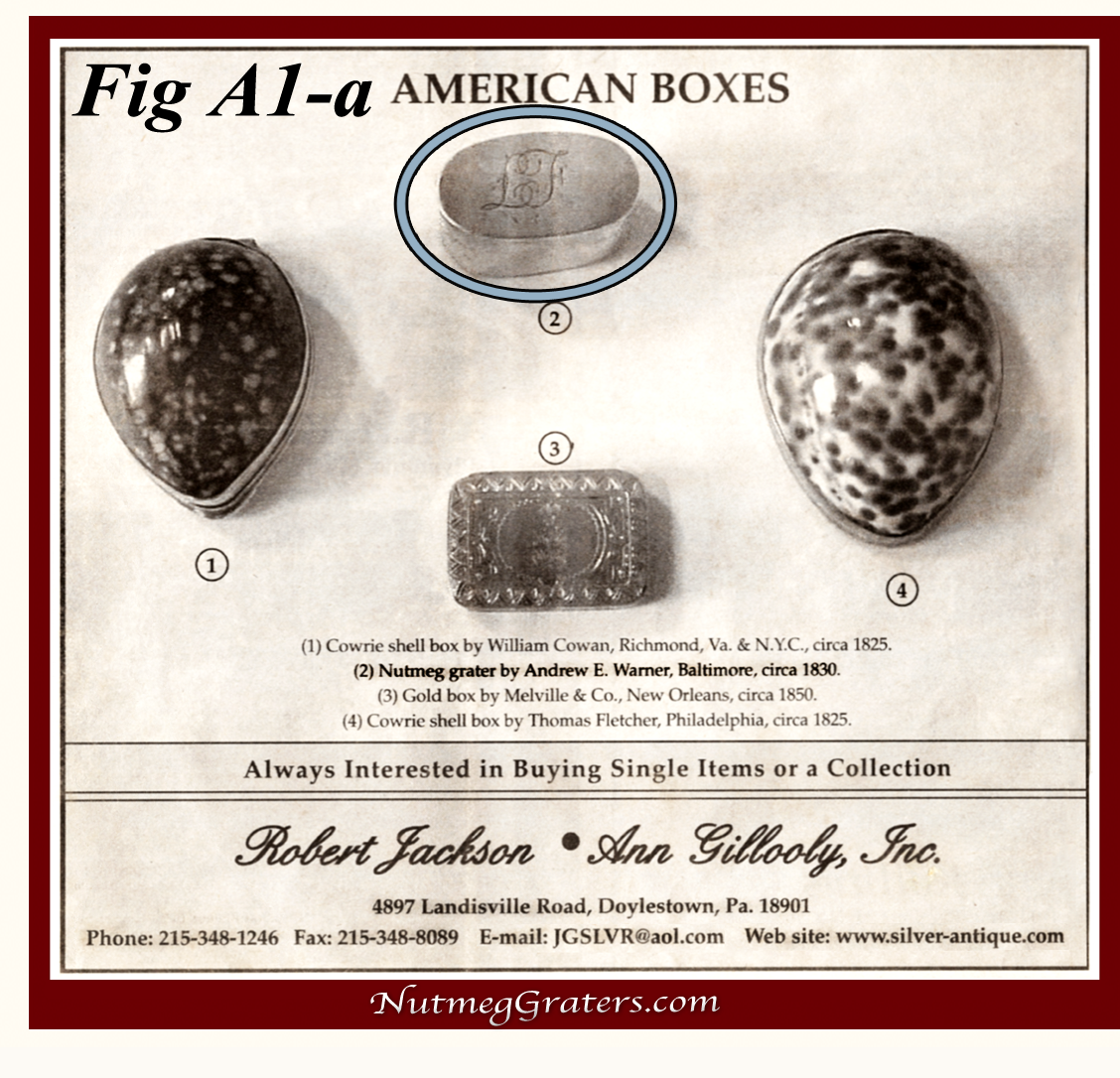 authenticated Warner nutmeg graters, each is very distinctive in form and styling from other silversmiths, each bears a maker's marks associated with their period when produced, and each exists having well established provenance.
authenticated Warner nutmeg graters, each is very distinctive in form and styling from other silversmiths, each bears a maker's marks associated with their period when produced, and each exists having well established provenance.
After 2004, multiple silver nutmeg graters began appearing in the antique market bearing one specific "A. E. WARNER" and "11" set of marks. Unlike previously authenticated Warner examples, their form and styling are of a more common variety, being nontypical to the already confirmed examples made by the Warners. Other than described as "coming from the antique trade", each example lacks any established and specific provenance. Because of this, further study of these items appeared warranted.
Investigation Profile #7 examines two silver nutmeg graters, each bearing identical "A. E. WARNER" and "11" maker's and silver standard mark.
Form and Style:
Compiled for more than 30 years, the Klopfer Image File represents the documentation, study and image collection of more than 3500 silver nutmeg graters: [sources include but are not limited to ~ books and auction catalogs, on-line sales or auction archival resources, private and public collections.] This private file details nutmeg grater form, decorative styles, and marks. This data collection is useful when making comparative assessments, and it forms a bases to show that the two nutmeg graters in question are in forms produced between Circa 1770 to 1900, with decorative styling known with the (Fig A~ series) from 1735 through the 1850's and with the (Fig B ~ series) from 1750 through Circa 1800. These are forms and styles seen widely and known to be produced over a lengthy duration.
Two Nutmeg Graters With Identical Maker's Marks "A. E. WARNER" Under Study:
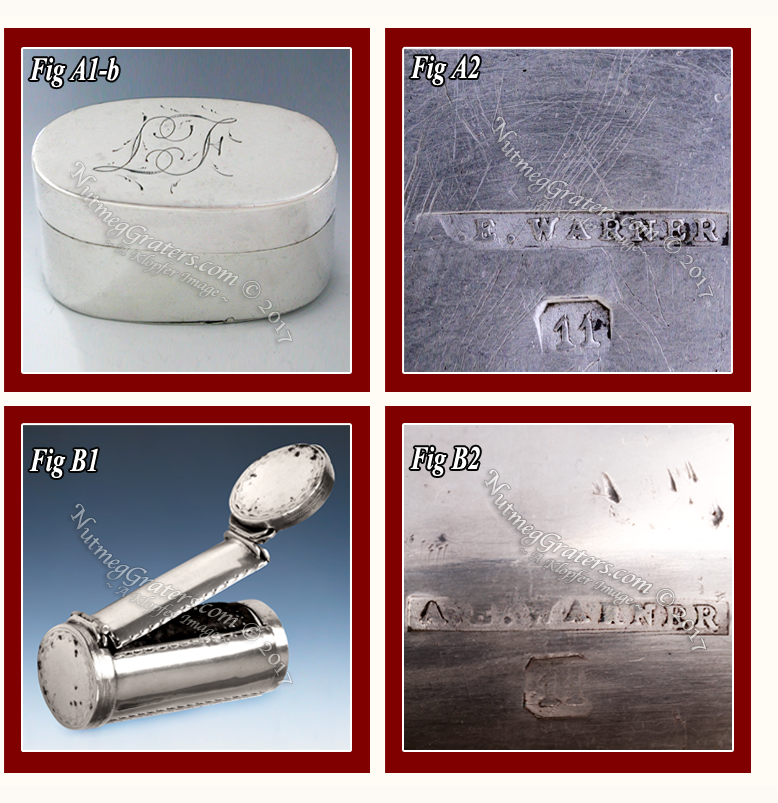
Purchase ~ Background Information:
(Fig A1 {within blue circle}, Fig A1-a [and A~series]) An oval shaped silver nutmeg grater was purchased from Robert Jackson • Ann Gillooly, Inc, 4897 Landisville Road, Doylestown, PA, 18901. The firm's advertisement was published in the Maine Antique Digest, January 2005 page 31-B, which stated for sale: "(2) Nutmeg grater by Andrew E. Warner, Baltimore, circa 1830." In addition, the seller later wrote the description "Nutmeg Grater by ANDREW E. WARNER, Baltimore, c. 1830. Oval Nutmeg Grater with hinged lid bearing the contemporary script initials 'LF'; the inside of the box with a pierced grater and the base with a ⅔ hinged lid bearing the marks 'A.E.WARNER' '11' inside the lid."
(Fig B1 [and B~series]) A cylindrical silver nutmeg grater with double hinged side and top cover was provided for inclusion within this study (made available to photograph on loan by a private source). Engraved using simple border design along its edges, this nutmeg grater is crudely decorated with unevenly executed bright-cut and punch banded borders [SEE enlargement of details, below]. (Fig B2) shows the "A. E. WARNER" "11" marks.
Review of the Literature:
The Warner family of Maryland and their silver products are extremely well researched. Three well known authors and authorities on Baltimore silver are Jennifer Faulds Goldborough, Martha Gandy Fales and Patrick M. Duggan, all referenced within this study. These scholars provide a wealth of data pertaining to the quality and the decorative design of silver products by A. E. Warner Gold and Silversmiths and other Baltimore silversmiths.
"Throughout the colonial period and well into the nineteenth century, . . . nutmeg graters were . . . occasionally made here" in America. One example is a "nutmeg grater, by Andrew E. Warner, Baltimore c. 1840." (Page 102 & 103, Fales, 1970). "American {silver} nutmeg graters are uncommon." (Davis, 2002). "American-made nutmeg graters are extremely rare as is silver from this period of Andrew Ellicott Warner's long and prolific career." (Goldsborough, 1983).
Regarding the Baltimore usage of the "11" standard mark (Fig C), Goulsborough describes that, "Numerical quality marks first appear after the passage of the 1830 Assay Law. . . . The new law required silver that was not assayed to be marked with a numeral which indicated the amount of silver contained per troy pound of twelve ounces. Thus, the numerical quality mark '11' refers to the Old Baltimore assay standard alloy composed of 11 ounces of pure silver to 1 ounce of base metal. 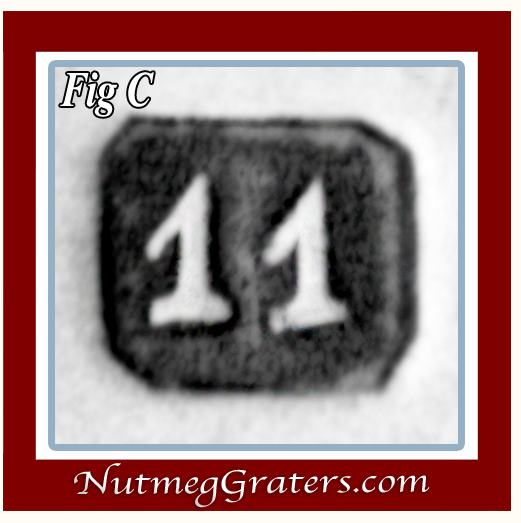 . . . The often-seen mark '10.15' refers to the common coin standard of 10 ounces and 15 pennyweights (dwts.) pure silver to 1 ounce and 5 dwts. of alloying metal. . . . Most of the silver made in Baltimore between 1830 and 1860 carries one of these marks or a variation such as '11/12'. Occasionally A. E. Warner used an '11-2' mark to designate the sterling standard. . . . A rare mark used by S. Kirk employs the word 'crown' over '10.19' to indicate that the quality is that of French coins. . . . The use of these numerical quality marks continued late into the nineteenth century with S. Kirk & Son using marks '11OZ' and '10.15' as late as the 1890's." (Page 32, Jennifer F. Goldsborough, 1984.)
. . . The often-seen mark '10.15' refers to the common coin standard of 10 ounces and 15 pennyweights (dwts.) pure silver to 1 ounce and 5 dwts. of alloying metal. . . . Most of the silver made in Baltimore between 1830 and 1860 carries one of these marks or a variation such as '11/12'. Occasionally A. E. Warner used an '11-2' mark to designate the sterling standard. . . . A rare mark used by S. Kirk employs the word 'crown' over '10.19' to indicate that the quality is that of French coins. . . . The use of these numerical quality marks continued late into the nineteenth century with S. Kirk & Son using marks '11OZ' and '10.15' as late as the 1890's." (Page 32, Jennifer F. Goldsborough, 1984.)
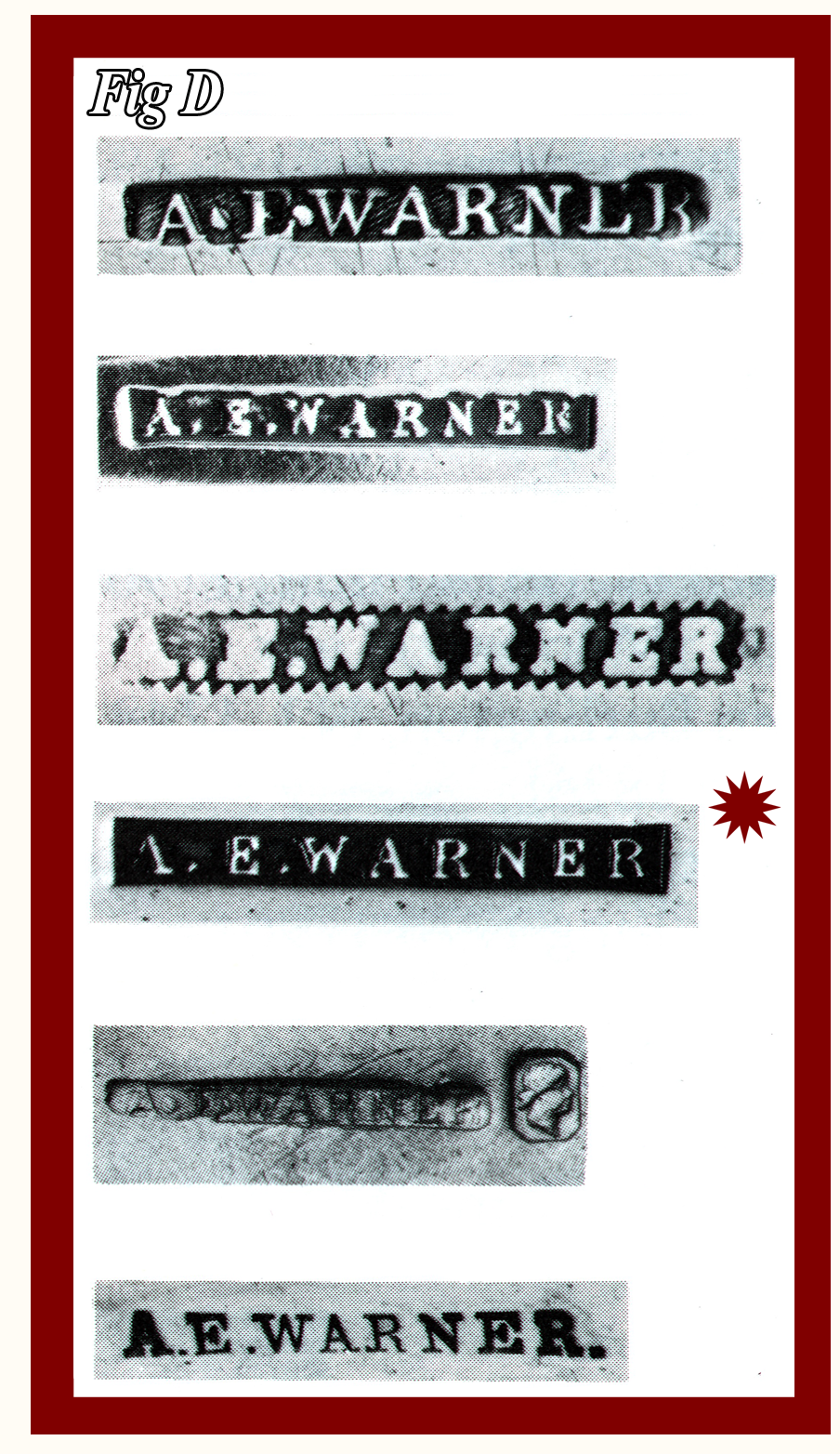 Goldsborough reports findings from an early nineteenth century silver assay study (Circa 1830's), writing that "In order to see if the Standard was followed, nine pieces ranging in date through the active Assay Office period were tested for silver content. Perhaps as surprising as the fact that pre-Assay sterling marked Baltimore silver tested relatively low in quality was the relevation that Assay period silver was of high quality. Of those tested, the highest was 95.5%, in fact, five of the nine tested were above sterling standard and two others were only very slightly below 92.5%. The remaining two pieces also averaged at least the Assay Office Standard of 91.7% silver." (Page 19, Jennifer Faulds Goldsborough, 1975.)
Goldsborough reports findings from an early nineteenth century silver assay study (Circa 1830's), writing that "In order to see if the Standard was followed, nine pieces ranging in date through the active Assay Office period were tested for silver content. Perhaps as surprising as the fact that pre-Assay sterling marked Baltimore silver tested relatively low in quality was the relevation that Assay period silver was of high quality. Of those tested, the highest was 95.5%, in fact, five of the nine tested were above sterling standard and two others were only very slightly below 92.5%. The remaining two pieces also averaged at least the Assay Office Standard of 91.7% silver." (Page 19, Jennifer Faulds Goldsborough, 1975.)
Several modern silver analysis studies, assessing Baltimore silver, were conducted during the 1970's and 1980's. From available data, NutmegGraters.Com extracted silver assay fineness with 11 A. E. Warner items assessed using Energy Dispersive X-ray Fluorescence Analysis (ED-XRF). The silver assay fineness results, with the date when produced, are as follow:
[90.91~(1805); 91.00~(1805); 91.89~(1805); 90.45~(1810); 94.42~(1812); 92.04~(1815);
92.10~(1823); 91.43~(1824); 90.47~(1924-9); 92.64~(1830); 93.11~(1830).]
None of the A. E. Warner items assessed yielded silver assay fineness totals falling below the standard mark applied to an article.
Therefore, Warner item's silver content "fineness" either matched or exceeded the silver quality implied by Warner's standard marks (and such was found with Baltimore silver, in general). Goldsborough surmised that "Perhaps Baltimore smiths found that it was simplest, and perhaps even cheapest, to use English silver items which were known to be consistently high in quality as their raw material." (Page 19, 1975).
Among 11 Warner maker's marks, there are 6 different "A. E. WARNER" examples (Fig D). (Eighteenth And Nineteenth Century Maryland Silver, The Baltimore Museum of Art, Page 198, 1975.) Using a red star, NutmegGraters.Com calls attention to the fourth "A. E. WARNER" maker's mark which was predominantly used following the year 1830 and which most exactly resembles the maker's marks located on the two nutmeg graters under study.
Review of Warner Manuscripts & Records:
The collections in the H. Furlong Baldwin Library at the Maryland Historical Society include 60,000 books, 800,000 photographs, 5 million manuscripts, 6,500 prints and broadsides, 1 million pieces of printed ephemera, extensive genealogy indexes, and is rich in documents pertaining to Maryland's silversmiths. The library holds a treasure trove of primary sources pertaining to A. E. Warner Gold and Silversmiths. Of key importance to this study are the Andrew E. Warner Account Books 1839~1860 and the Andrew Elliott Warner Jr Account Books 1880~1891. Within these volumes, each sales transaction is neatly detailed and dated. Based on these manuscripts, the Warner silversmiths infrequently produced silver nutmeg graters as "commissioned items". The last nutmeg grater sold by the company was on November 29, 1886, with the final entry stating to: "Maj. D. H. Thomas ~ nutmeg grater to match sample to cost $16, 1521 ax".
Within the Maryland Historical Society "artifact collection" is an A. E. Warner silver nutmeg grater, dating "Circa 1805". Based on Warner manuscripts, records, and collections, Andrew E. Warner nutmeg graters are very rare, produced on commission and manufactured by A. E. Warner Gold and Silversmiths across their long duration in business. NutmegGraters.Com found no evidence that the company ever produced silver nutmeg grates as an "in stock item".
An Investigative Portfolio:
The following three investigative analysis procedures were used to assess the nutmeg graters which bear suspect "A. E. WARNER" maker's marks:
MAKER MARK ANALYSIS ~
[NOTE: Slight variations are expected when comparing the same maker's mark as applied to different silver items. The best account for this is detailed in Marks of American Silversmiths in the Ineson-Bissell Collection, Louise Conway Belden, University Press of Virginia, 1980; "Identification of Marks", Pages 21-23. The factors to account for subtle differences between marks struck using the same die include (but are not limited to): silver composition, hardness and quality; "differences in reflect wear, dirt or photographic technique"; the direction of the strike force applied by the silversmith, the amount of strike force; die slippage or lateral movement during the strike, die wear, and/or re-strike (or bounce) of the die. To determine usage of the same die, compare features of spacing, proportions, overall layout, shaping, styling, and most importantly, the identification of unique die flaws and shaping features of lettering and characters.]
[NOTE: Photographing a maker's mark: a Canon MP-E-65 mm lens allows for a super-macro image (extreme close-up) which shows exceptional detail when viewing an original image on a high definition monitor/screen. The detail in images using the Canon MP-E-65 lens captures a high resolution photograph in magnificent quality. For example, this lens captures the image of one third of the tip of a pencil point to yield a high resolution image as large as 40 inches by 40 inches (100 cm X 100 cm). When viewing images throughout this website, keep in mind that by reducing resolution required for an ink-jet printer (at 300 DPI), the image quality is lessoned to only satisfactory image quality, and for a website (at 72 DPI) the image quality details are significantly lessoned to fair or marginal qualities. The actual Direct Visual Comparison between "Marks" was conducted using the highest resolution images available on a high-definition 27 inch monitor.]
[NOTE: To view most of the Images within this Web Page in enlarged detail. ~ First, "right-click" with curser directly on the image and then select "Open Image in New Tab".]
(I). Analyzing Marks ~ Direct Visual Comparison Of An Authenticated "Maker's Mark" Against A Spurious "Maker's Mark":
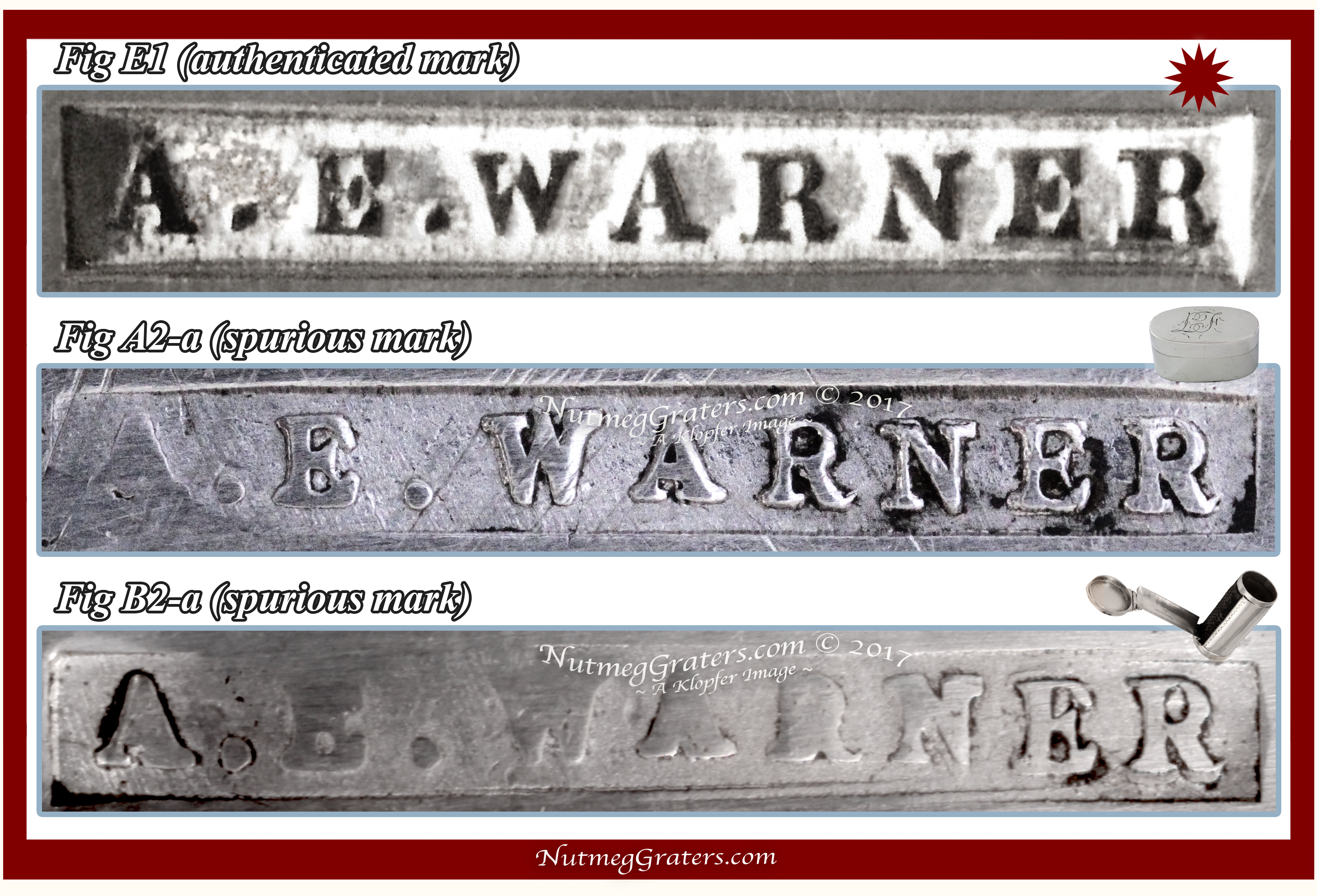
The authenticated "A. E. WARNER" maker's marks (Circa 1830 ~ 1845+/-) was acquired from multiple sources [including Winterthur's Decorative Arts Photographic Collection (DAPC), a collection containing abundant photographic images of American silver and their maker's marks; Silver In Maryland, Museum And Library Of Maryland History/Maryland Historical Society; Eighteenth And Nineteenth Century Maryland Silver In The Collection Of The Baltimore Museum Of Art; Maryland Silversmiths 1715-1830, Pleasant & Sill; The Warner Family Silversmiths To Baltimore, The Peale Museum; Marks Of 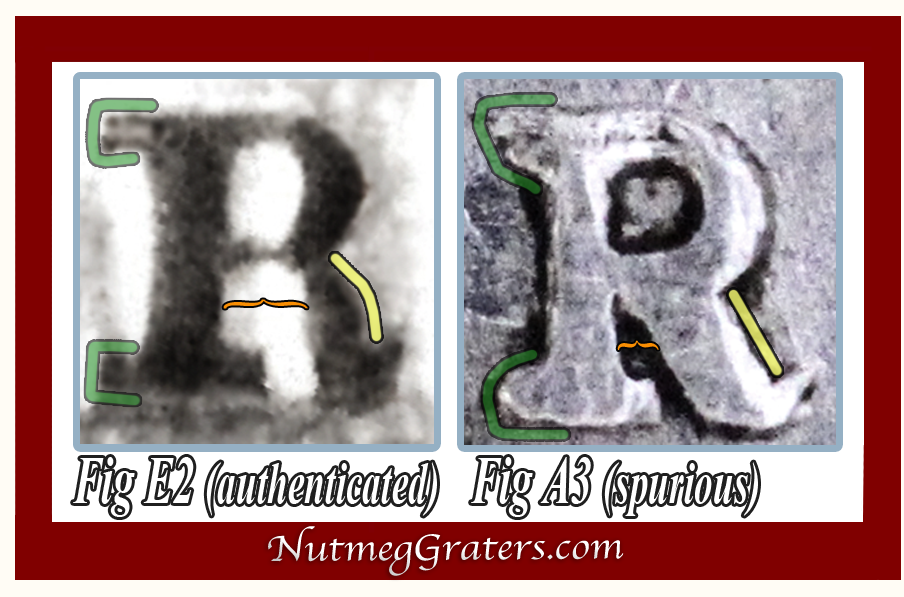 American Silversmiths, Beldon; American Silversmiths And Their Marks, Ensko; Silver of the Americas, 1600-2000, American Silver in the Museum of Fine Arts, Boston, Jeannine Falino & Gerald Ward Eds.; and other on-line sources]. Provided a verified "A. E. WARNER" maker's mark image (Fig E1), a direct visual comparison was contrasted against the Canon MP-E-65 images of the maker's marks from the nutmeg graters in question: (Fig A2-a) and (Fig B2-a).
American Silversmiths, Beldon; American Silversmiths And Their Marks, Ensko; Silver of the Americas, 1600-2000, American Silver in the Museum of Fine Arts, Boston, Jeannine Falino & Gerald Ward Eds.; and other on-line sources]. Provided a verified "A. E. WARNER" maker's mark image (Fig E1), a direct visual comparison was contrasted against the Canon MP-E-65 images of the maker's marks from the nutmeg graters in question: (Fig A2-a) and (Fig B2-a).
Using Direct Visual Comparison between high definition images, by comparing a genuine "A. E. WARNER" maker's mark (Fig E1) against an alleged counterfeit maker's marks (Figs A2-a & B2-a), many significant differences become apparent. To illustrate these concerns, some of these features are specifically detailed below:
~ (Figs E2 & A3) compare the final 'R' characters. Observing the mark in question (Fig A3), the right leg of the 'R' is rigidly non-curvaceous and fat [highlighted using a straight yellow line], while the right leg from the confirmed example (Fig E2) is rounded and well formed. Contrasting (Figs E2 &A3) [shown in orange], the spacing, proportions and shaping between the legs are significantly dissimilar; while the authenticated 'R' example (Fig E2) is meticulously formed, the spurious character 'R' has narrowly spaced legs with jagged edges. Viewing the letter's serifs [outlined within green bracketing], the authenticated 'R' (Fig E2) has fully extended serifs which are typical letter symbol craftsmanship on silver from this period; while the serifs on the problematic 'R' are crudely shaped with the top serif inaccurately extended angularly from its stem. [NOTE: The reader can observe that there are several poorly formed serifs throughout the spurious maker's marks (Figs A2-a and B2-a).]
~ (Figs E3 & A4) contrast the authenticated verses the spurious "A. E. WARNER" maker's marks with their apportionment spacing between letters 'A.E' against letters 'E.W' [highlighted using purple brackets]; while at the same time, compare distribution in spacing of their two 'period' characters between these two marks [spacing between 'period' marks are contrasted using four green brackets]. 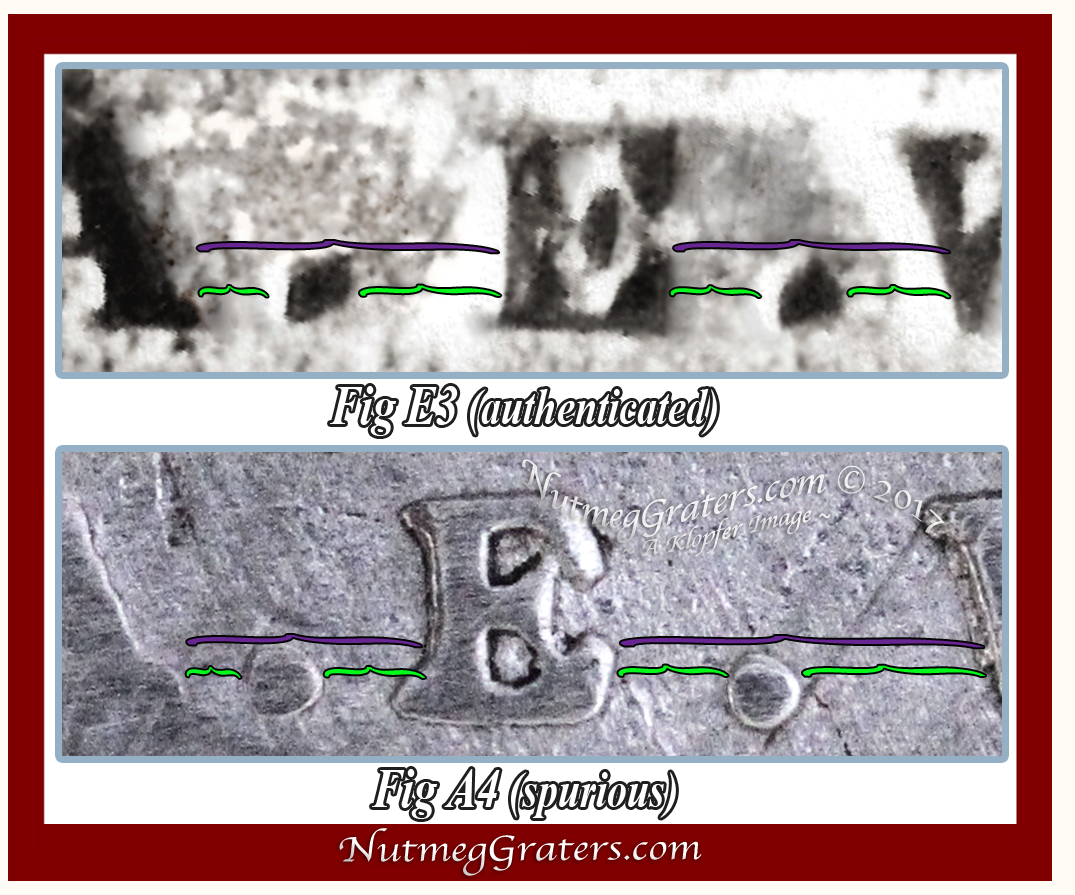
Observing the "purple brackets" with the authenticated maker's mark, spacing of the letter 'E' is centered midpoint, and thus, the spacing between letters 'A.E' and letters 'E.W' is equally proportioned; yet with the problematic mark the "purple brackets" show disproportionment where letter 'E' is left of center; and thus, the spacing of letters 'A.E' are closer together, while the 'E.W' are spaced farther apart.
When comparing the positioning of 'period' marks, the "green brackets" illustrate a 'die flaw' in spacing within the authenticated mark, which is then mimicked within the spurious marks. Observing the authenticated mark (Fig E3), notice the apportioned spacing of each 'period' in relationship to their adjacent letter characters. While the 'period' between the 'E' & 'W' characters appears centrally located (mid-point), the 'period' between the 'A' & 'E' characters appears just slightly off-centered toward the 'A'. [This slight mis-spacing within the authenticated mark constitutes a 'die flaw'.]
It appears that the die maker of the spurious mark (Fig A4) attempted to duplicate this 'die flaw' found within the authenticated maker's mark; notice how the 'period' between the 'A' & 'E' characters is off-centered toward the 'A'. [The forger attempts to imitate the apportionment with the 'periods' seen in the original maker's mark, but fails to match this overall proportion because the letter 'E' is inaccurately off-center.]
Comparing an authenticated maker's marks with the marks in question, the maker's marks are mismatched in letter spacing and proportioning. Further, the quality in die-cutting seen with the spurious maker's mark displays malformed letter edges and inaccurate shaping of serifs.
[NOTE: Analysis Method I permits the viewer to contrast the maker's marks on each nutmeg grater under investigation (Figs A-series & Fig B-series), allowing each viewer to confirm for themselves that the two marks in question (Figs A2-a and B2-a) are the product of the same spurious marking instrument (an implement known as a: "name stamp" or "touchmark stamp"), which do not match the authenticated sample.]
(II). Analyzing Form and Styling of an Authenticated Nutmeg Grater By A. E. Warner Gold and Silversmiths Against Two Examples Under Investigation ~ Direct Comparison:
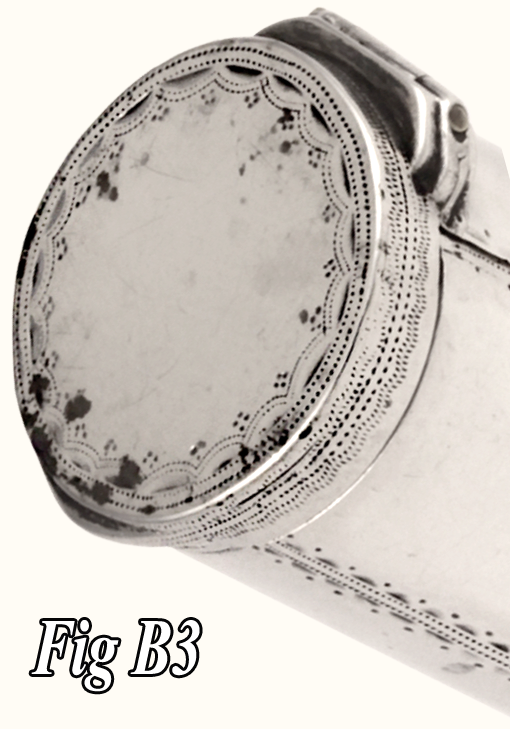 Established under Baltimore Statutes and Ordinances in February 1830, the standard mark "11" (Figs A2, B2 & C) indicates products made after this date and also is indicative that each item of silver has a "fineness" of 91.7% pure silver content. Based on A. E. Warner Gold and Silversmiths company records,
only a few silver
Established under Baltimore Statutes and Ordinances in February 1830, the standard mark "11" (Figs A2, B2 & C) indicates products made after this date and also is indicative that each item of silver has a "fineness" of 91.7% pure silver content. Based on A. E. Warner Gold and Silversmiths company records,
only a few silver 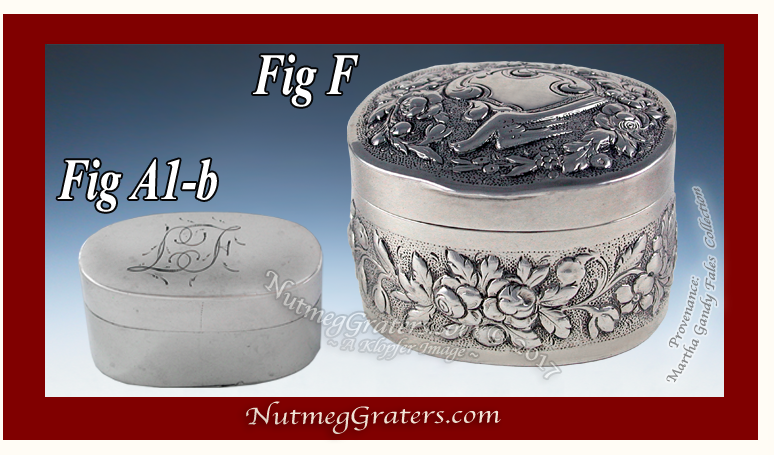 nutmeg
nutmeg
graters were produced after this 1830's date.
NutmegGraters.Com is aware of 3 authenticated nutmeg graters by A. E. Warner Gold and Silversmiths produced after 1830. All three of these confirmed Warner nutmeg graters are uniquely styled, and created using atypical, groundbreakingly novel designing.
NutmegGraters.Com is fortunate to have one example made available for analyzing form and styling against the two items under study.
Beginning Circa 1823 ~ 1826, the repoussé styling of silver became so predominant in Maryland that today it is known as the "Baltimore Style" (also, sometimes called the "Maryland Style"). The "Baltimore Style" is a highly ornate surface styling inspired after the mid-eighteenth century method of hammering inside a silver object to raise on the outside surface an ornamental relief decoration. It is long established that from the end of the first quarter to the late nineteenth century, A. E. Warner Gold and Silversmiths worked almost exclusively in the "Baltimore Style", and NutmegGraters.Com has documented that all authenticated Warner nutmeg graters from this period are in this style. Serving as a model example, one well documented A. E. Warner artifact is the large silver table nutmeg grater (Fig F) in repoussé decoration with foliate roses, florals and leaves, having a dove and cartouche on its lid. [Of special interest, this repoussé oval silver pocket nutmeg grater was illustrated in Early American Silver, by Martha Gandy Fales, Page 103, 1970 (photographed by Richard Merrill). In addition, it is documented within Winterthur's data study ~ Winterthur Decorative Arts Photographic Collection 1971: 71.2961.]
Regarding both the small oval nutmeg grater (Fig A1-b) and the cylindrical nutmeg grater (Fig B3), their decorative motif is in the "planish style" (also referenced as in the "classical" or "neoclassical" style). While the former example is decorated only with engraved initials, the latter is embellished using crude punch banding and bright-cut borders along its perimeters. Notice the primitive and haphazard quality of the punch banding around the rim of the top cover of the cylindrical grater. This method and rough quality adornment is typical to workmenship know during the eighteenth century, while, in contradiction, this nutmeg grater bears a "Baltimore" standard mark of "11", indicative of an item produced after February 1830.
Based on their form and styling, neither of the two nutmeg grater under investigation conform to the design or quality found on A. E. Warner nutmeg graters produced when their "11" standard marks would imply, after 1830.
(III). Energy Dispersive X-ray Fluorescence Analysis (ED-XRF):
Dr. Jennifer L. Mass, Ph.D., of Scientific Analysis of Fine Art, LLC and formerly, the Senior Scientist for Winterthur Museum, conducted x-ray fluorescent analysis on oval shaped silver nutmeg grater (A~series) to measure the presents of its metal elements and the "fineness" of its silver content. "It is thought that the mark might be spurious, and analysis was conducted to determine if the alloy of the piece is period appropriate." Early "silver" [Ag] contained impurities such as "gold" [Au] and "lead" [Pb] which, after 1840 ~ 1860, were fully extracted during the refinement process of silver. Therefore, identifying these impurities indicates that an item's fabrication was prior to this time. Secondly, the degree of "fineness" (or, percentage of silver verses other metals) in antique silver varies among different countries and aides to support knowledge of its place of origin. Three test spots were sampled as follow:
Grater (Fig A~series) - Oval Box Nutmeg Grater marked "A. E. WARNER" "11":
[Test Spot #1] (Underside) [Test Spot # 2] (Lid)
| ELEMENT | CONCENTRATION |
|---|---|
| Ag La1 | 89.7 wt. % |
| Cu Ka1 | 9.8 |
| Au La1 | 0.10 |
| Pb La1 | 0.22 |
| Ag Ka1 | 89.9 |
| ELEMENT | CONCENTRATION |
|---|---|
| Ag La1 | 86.6 wt. % |
| Cu Ka1 | 13.0 |
| Au La1 | 0.10 |
| Pb La1 | 0.30 |
| Ag Ka1 | 86.5 |
[Test Spot #3 ] (Side Edge)
| ELEMENT | CONCENTRATION |
|---|---|
| Ag La1 | 89.2 wt. % |
| Cu Ka1 | 10.2 |
| Au La1 | 0.12 |
| Pb La1 | 0.32 |
| Ag Ka1 | 89.3 |
Findings are based on copper [Cu], gold [Au] and lead [Pb] concentrations. Dr. Mass wrote: "The A. E. Warner monogrammed oval grater has an '11' mark that should indicate a silver purity standard of 91.7 wt. % silver. Alloy analysis reveals that the standard implied by the 11 mark is not met in this object, and that the piece is a lower-grade coin silver (below 90 wt. %). This coin silver composition is certainly consistent with an American piece, and the trace amounts of gold and lead are consistent with a pre-electrolytic refining date."
Scientifically discovered using ED-XRF assessment, the silver standard mark of "11OZ" [91.7 % silver] was revealed to significantly misrepresenting the nutmeg grater's actual silver "fineness" ~ which is problematic for an item alledgedly produced after 1830 period when Baltimore silver standard quality was well-founded and beyond reproach. This standard mark of "11" [91.7% silver] misrepresents the actual measured silver "fineness" with this nutmeg grater at "10.05" [88.5% silver] which is of "low" coin silver "fineness". This ranks even lower than the Spanish dollar coin, which has an average silver content "10.15" [89.6%]. Therefore, this standard mark seems a fraudulent and a later addition, thus causing further concern against the legitimacy of the "A. E. Warner" maker's mark.
Grater (Fig B~series) - Cylindrical Silver Nutmeg Grater with Double Hinged Side and Top Covers marked "A. E. WARNER" "11": [ ED-XRF assessment has been pursued by the owner of this item and will be included within this study at a later time (if made available). ] |
Investigation Outcome:
Based on the results from this investigative profile, the two silver pocket nutmeg graters under study bear the appearance of "spurious marks" and thus, are falsely attributed as the work of A. E. Warner Gold and Silversmiths of Baltimore, Maryland USA (a company in operation 1805 ~ 1893; the marks investigated here compare to the similar, and authenticated "A. E. WARNER" "11" marks Circa 1830 ~ 1845+/-). Not withstanding the apparently counterfeited maker's and standard marks, both silver pocket nutmeg graters appear as genuine eighteenth century antiques, that evidently were originally unmark by their makers.
The "fineness" quality with the oval shaped silver nutmeg grater (Fig A~series) is very low "coin silver" and is atypical for an English example. Based on available data, this nutmeg grater is attributed as a mid-eighteenth century North American example, originally being unmarked and therefore, the work of an unknown silversmith.
Observing available particulars with the cylinder form silver nutmeg grater (Fig B~ series), it is likely of English origin, being produced prior to the English Statutes at Large of 1790 and therefore, originally unmarked. The primitive quality in punch banding and bright-cut decoration support the dating to this period. Energy Dispersive X-ray Fluorescence Analysis study is recommended to confirm this attribution.
This investigation evaluation is indicative that neither nutmeg grater under study is the work from A. E. Warner Gold and Silversmiths of Baltimore, Maryland.
[KLOPFER article © September 2017]